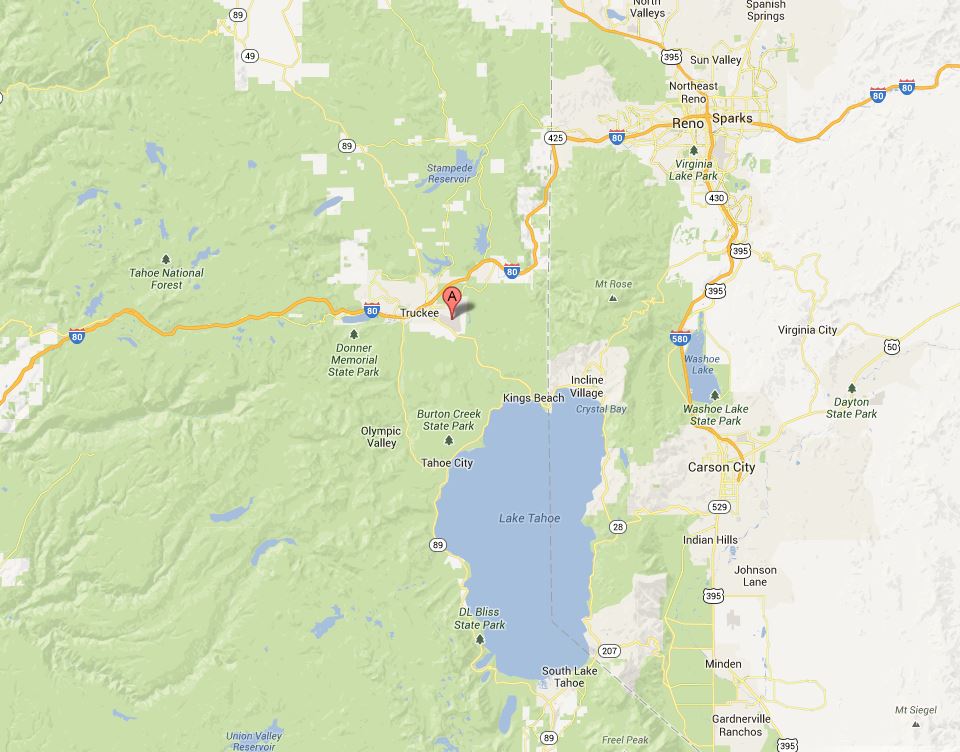
I was checking my inbox for news updates the other day when I came across this story about a plane crash in Truckee, Nevada County, just north of Lake Tahoe, on the Californian side:
Small plane crashes in Truckee; pilot not hurt
June 11, 2013
Authorities say a small plane that took off from Southern California missed the runway and crash landed at an airport in the Sierra town of Truckee.
Despite severe damage to the plane, the pilot walked away uninjured.
Nevada County sheriff’s Lt. Alicia Milhous says the 62-year-old pilot took off alone from John Wayne Airport in Orange County shortly before noon Tuesday in a single-engine Cirrus SR22.
About 90 minutes later he approached the Truckee Airport amid gusty winds, clipped a trailer on the way down and crashed into brush about 40 feet off the runway.
Milhous says the plane had heavy damage but the pilot, whose name has not been released, was not hurt.
The cause of the crash has not been determined.
The National Transportation Safety Board will investigate.
Small plane crashes Thursday near Truckee airport
May 23, 2013
Crews were in the process of rescuing the lone occupant of a small plane that went down Thursday afternoon near Truckee Tahoe Airport, according to the Nevada County Sheriff’s Office.
At about 3 p.m., NCSO received a report that a single-engine aircraft crashed 7 miles east of the airport, near the California/Nevada border, said Undersheriff Joseph Salivar. The report came from the plane’s occupant, using a cellphone. His injuries were unknown.
Helicopter rescue crews from Calfire and the California Highway Patrol assisted in airlifting the victim from the crash site.
The cause of the crash is unknown. It was unclear as of late Thursday if the plane was flying to or from the Truckee airport.
The investigation has been turned over to the Federal Aviation Administration and the National Transportation Safety Board.
Two plane crashes at or near a small airport in one month? Just unlucky I guess.
But then I found this:
Cal Fire: Small plane crashes in Tahoe Nat’l. Forest
May 17, 2013
Cal Fire, the California Highway Patrol and a medical helicopter responded to small plane crash in the Tahoe National Forest.According to Federal Aviation Adminstration spokesman Allen Kenitzer, a Cessna 421 was headed to Reno when it was lost off radar about 1:25 p.m.
Cal Fire dispatchers report the air ambulance spotted the downed twin engine plane as did a CHP aircraft crew.
Sierra County sheriff’s deputies had the crash site sealed off until NTSB investigators could reach the area on Friday.
The smoking wreckage could be seen from Verdi peak a few miles to the north just before sunset Thursday evening.
There was no early word on the status of the plane’s pilot and/or passengers.
The Cessna 421 is an eight seat, pressurized aircraft often used as a corporate plane. It was on final descent into Reno when it vanished off radar. The FAA said the aircraft is registered to TRI-WINGS LLC based in Reno.
Dispatchers said witnesses said they saw a fireball in the sky before the plane went down.
Verdi Peak is in California, about 25 miles west of Reno, Nevada and 107 miles northeast of Sacramento.
I guess three plane crashes in one month near an airport that serves a town of 16,000 inhabitants makes them ‘very unlucky’.
In addition, there was a fourth plane crash on the other side of Lake Tahoe between Carson City and Reno, Nevada on May 15, 2013. Again, it involved a small aircraft and again there was no explanation for why it crashed.
There was also this unexplained small aircraft crash near Lake Tahoe last August. In fact, there were two that month. The first, on August 2nd, was also unexplained and was – up until then – the ninth plane crash since 2008 at Truckee Tahoe airport itself.
This means that, altogether, there have been at least 11 plane crashes at just one tiny airport in four years – 15 if we include the other crashes to the north, east and south of Lake Tahoe!
I don’t know if there’s any connection between these events, but I’m wondering if that rate of plane crashes is normal for an airstrip that’s largely servicing general aviation, single-engine, private flyers?


How many plane crashes would be “normal”? How many total landings were there in the same time? (And how many car crashes in the same area in the same time?)
Truckee (TRK) is a special airport, especially in the summer. Airplanes have poor performance when it’s “hot and high” — TRK is already 6000 feet up, and when it’s 90 degrees there, the air is very thin — it’s like being at 10,000 feet on a normal day. Sea-level pilots are often surprised by this, and aviation is not a forgiving environment.
It would be interesting to compare Truckee with South Lake Tahoe (TVL). TVL is a little higher than TRK, but being closer to Tahoe it’s usually a little cooler.
There is a factor of 82 times more accidents in non commercial aviation vs. commercial airline type operations due to less experience, very limited training, lack of instrument training, and possible poor or no maintenance……. Truckee is a rather high traffic airport being near Lake Tahoe. The altitude and summer time operations can cause even more problems as the pressure altitudes of up to 10000′ above sea level on a hot summer day mean higher relative maneuvering speeds near the airport, bigger turning radius in the approaches, and about a 20% higher sink rate in the descent. Finally, at that altitude the engines are slower to accelerate and develop less horsepower…….All that with the high terrain of over 10000′ in close proximity to the airport result in the high accident rate. With the terrain and winter weather and high altitude the challenges are even greater. The approach minimums are high as there are only non precision approaches to the airport and many arrivals would circle to land and be required to stay within a small distance from the airport to avoid high terrain in all directions…..Clouds, fog, and snow may obscure terrain causing more pilots to inadvertently become disoriented if they lose ground contact……..There are many traps for the unsuspecting private pilot at this airport…..
The majority of the planes crashing at Truckee and So. Lake Tahoe are usually pilots unfamiliar flying at high density altitude. What the general public doesn’t know is that a non-turbocharged engine is only capable of producing approximately 75% of rated engine power at 5,000 feet density altitude. i.e., if your plane has a 200 hp engine, at 5,000 feet density altitude your engine would only be producing 150 hp. On a hot summer day, Truckee(elevation 5,900 feet) and So. Lake Tahoe’s thinner air density altitude could be equivalent to 10,000 feet above sea level, as Wendell Fleming in the above post explained. The thinner air also has a detrimental effect on the prop producing thrust, and the wing producing lift. If the pilot wasn’t experiencing mechanical problems, then I can only blame the pilot for not computing his take off weight allowable at the higher density altitude. Contributing to the fatal crashes is the fact that the typical pilot probably cannot bring themselves to stop trying to climb, and instead increase airspeed in order to fly around any obsticles to return to the airport. An overloaded plane will have a very slow rate of climb, or no climb at all. I’ve often experienced 100 feet per minute climb on a hot day, with a heavy load. If you expect it, then there is no problem. If you don’t expect such a slow rate of climb, and pull the nose of the plane higher to “force” a climb, the plane will eventually mush into the ground, or stall and fall toward the ground. That’s what I believe happens to many low time sea level trained pilots at high elevation airports. There are more factors involved but non-pilots would have difficulty understanding them so I won’t bother mentioning those factors here.